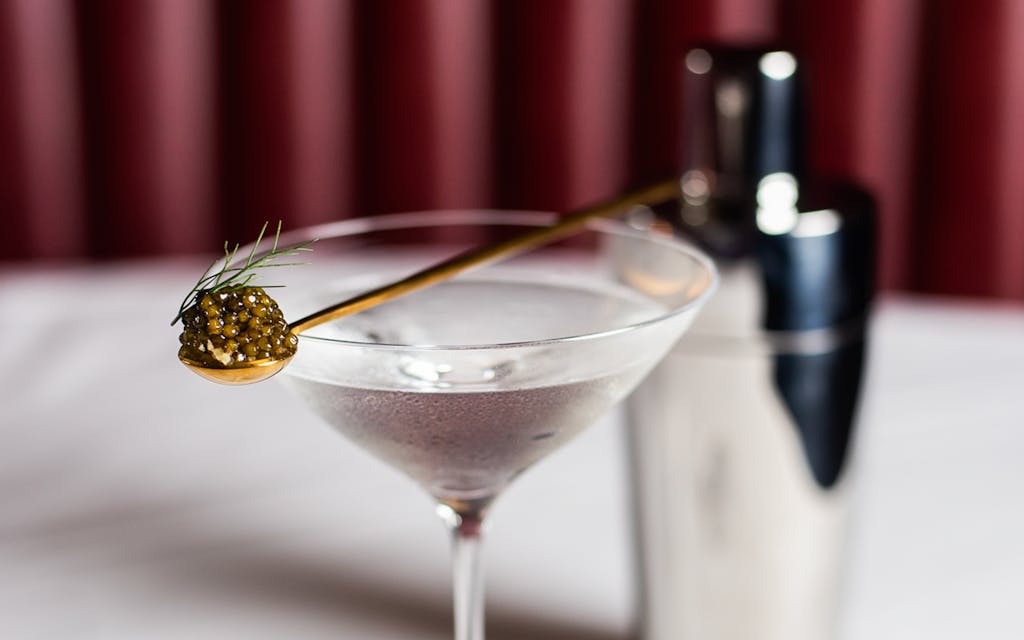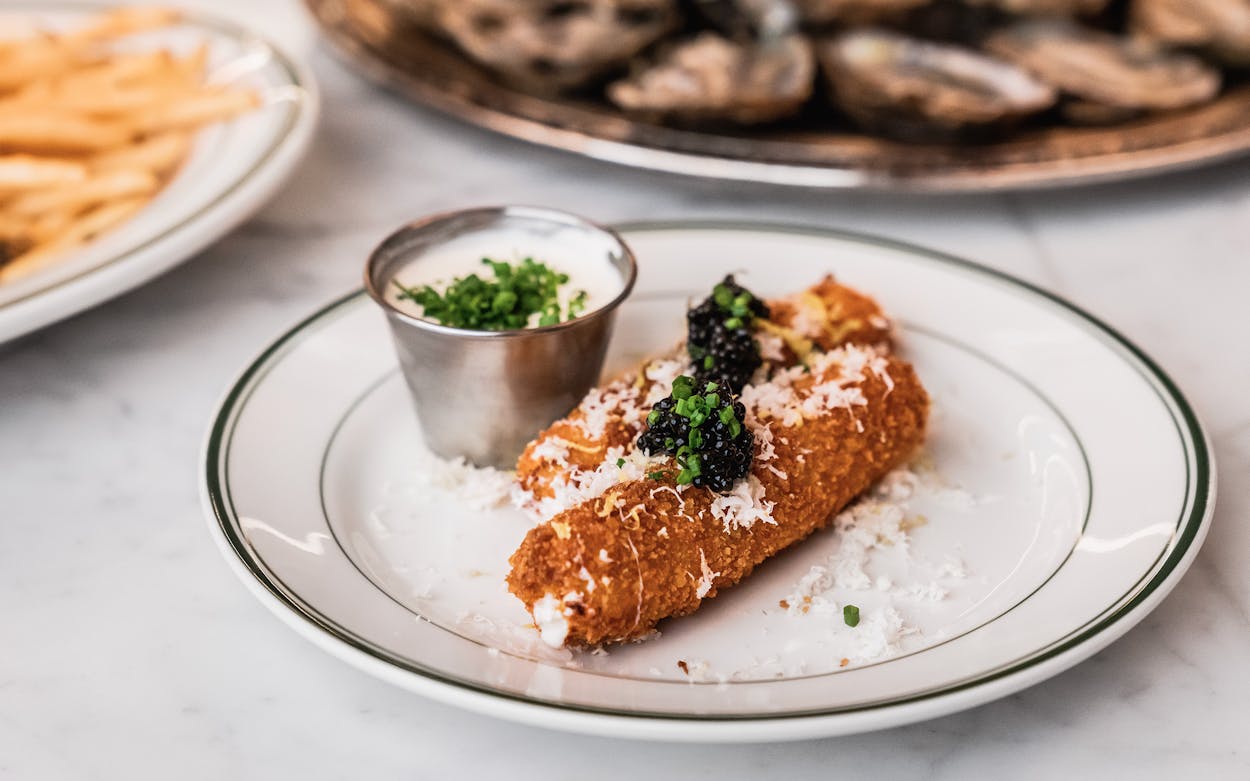“Let’s throw some caviar on it” is something Joe Zavala says a lot. As the pitmaster and co-owner of Zavala’s Barbecue, in Grand Prairie, his love of caviar began after he received a multiple myeloma diagnosis the same year his restaurant opened, in 2019. In an effort to create memories and savor life, he instituted a Champagne-and-caviar New Year’s Eve tradition. Now in remission, he carries tins of what he describes as “the taste of the ocean” to dollop on ribs and sausage. He insists it’s the only thing that could make barbecue better. (Although caviar has yet to make it onto the menu of his barbecue joint, he has served caviar on fajitas with his Green Sauce at the restaurant’s monthly speakeasies.) In Zavala’s words: “Caviar makes everything better.”
Historically sourced from the Caspian Sea, caviar has long been equated with aristocratic elegance. In the mid-fifteenth century, French Renaissance writer François Rabelais deemed caviar the finest possible hors d’oeuvre, and Shakespeare referenced it in Hamlet with his “caviar to the general” line.
Its reputation as a luxury item became official in the nineteenth century when it was served at leading hotels and restaurants in Western Europe, according to The Oxford Companion to Food. The traditional presentation includes blinis and crème fraîche, sometimes with shallots and chopped boiled eggs. A mother-of-pearl spoon ensures no metallic flavors corrupt the taste.
In spite of its association with formality, caviar has recently appeared on menus of Texas restaurants as an accoutrement of mozzarella sticks, fried chicken, hot dogs, and sorbet. These novel presentations are fueled by interest from younger diners (remember last year’s caviar “bumps” trend?) and cheaper, more sustainable fish eggs.
The wild beluga sturgeon originally responsible for producing caviar have been threatened by poaching, overfishing, and pollution. In 2006, the animal-protection arm of the United Nations instituted a one-year global ban of caviar exports from the Black and Caspian Seas, when it was estimated only 10 percent of one of the world’s oldest fish species remained in its native environment.
Official bans continue to this day. As a response to Russia’s invasion of Ukraine, the European Commission sanctioned Russian caviar imports. But the reality is that Russia now produces very little of the world’s caviar (around 8 percent in 2019), and it likely hasn’t been served in the U.S. since 2008, according to some experts. When overfishing led to trade bans, newer farms in China, Poland, Uruguay, Madagascar, and several other countries began raising sturgeon, which, as a result, has driven down the price.
A 2019 article in the Washington Post blamed China’s aquaculture farms for turning caviar into “a cheap snack” and predicted they would lead to the loss of caviar’s status. While it’s hard to objectively measure status, some purveyors have noticed caviar selling better in their stores.
Diane Roederer, owner of Houston shop DR Delicacy, has seen caviar sales increase 30 percent each year since she started importing to supply restaurants five years ago. During the COVID-19 pandemic, she made up for the loss of business from restaurants by opening sales to the public. Since people weren’t spending money at restaurants, “they spent a little extra on some delicacies,” she noted, adding that “caviar was definitely one of them.”
Roederer is now in talks to set up a caviar bar at the Houston Livestock Show and Rodeo next year. She says caviar is “an easy way to have a fun time,” and she believes the taste of roe harvested from aquaculture farms today is an improvement on the salty flavor she recalls from her childhood in France.
Zach Diamond sources fish eggs for his Austin-based company, Shag Caviar, largely from farms in Poland and China. Shag’s target market—those in their late twenties to early thirties—flock to the site to purchase osetra, Golden Kaluga, and Siberian caviar packed in glass jars with a topless mermaid label. A one-ounce jar costs $75 to $105 and ships throughout the U.S. When it isn’t sold out, Shag also offers wild-caught hackleback caviar from the Mississippi and Missouri Rivers for $34 an ounce.
“Caviar used to have this reservation for fine dining and special occasions, and it had this air of luxury. And it still has that,” Diamond says. “There’s just more younger people, especially, looking at caviar as something that they can try on their own without having to go to a Michelin-star tasting menu.”
While Texas has never had a Michelin-starred restaurant, caviar has consistently been served at upscale seafood eateries and steakhouses. At Nick & Sam’s, in Dallas, chef Samir Dhurandhar has offered it as a complimentary pre-dinner perk, along with bread, for 24 years. In the last few years, though, more Texas chefs are taking creative risks with the dish.
In the Woodlands, chef Jassi Bindra at Amrina serves D’Artagnan’s Ossetra Malossol caviar (a type with little salt) in a semi-traditional service with naan blinis and a foam whipped from shikanji, an Indian lemonade, for $240. He also puts caviar on top of golgappa, more broadly known as panipuri, in his Street Food tasting menu. In Dallas, chefs Junior Borges and Justin Mosley at modern Brazilian restaurant Meridian are currently serving Regiis Ova caviar on a nori tartlet with avocado and chives.
Chef Finn Walter says he never intended to put caviar on the menu of his Lubbock restaurant, the Nicolett, when it opened three years ago. He’s always avoided chasing trends, he says, but after having some leftover tins from a private event, he created a caviar special the next day, and it sold out. He added an appetizer with yucca chips and caviar for $16 in November of last year, sourcing mainly from the Caviar Co., founded by two sisters from Lubbock but based in San Francisco.
Walter says he became reacquainted with caviar about fifteen years ago when working at a restaurant in Napa Valley. He believes a lot of diners in Lubbock are like himself: well traveled and “happy to get [caviar] in their own backyard.” Caviar has gone in and out of style in California over the years, according to Walter, and he can’t say for certain what accounts for its resurgence in Texas. He guesses the mix of a traditional luxury item with a sustainable component is especially attractive these days.

The environment is a primary consideration for Corrin Ellis, chef at Dallas’s Tango Room, who added a caviar section—items range from $18 to $275 and include fish egg–topped deviled eggs, fried chicken and caviar, lobster-and-caviar toast, and a caviar trifle—in February. She buys from Black River Caviar, in Uruguay, which raises its fish in a constantly flowing freshwater system, because she considers its caviar to have the best taste from one of the world’s most sustainable aqua farms.
Sustainability is set to go even further. Plant-based caviar is already being served at Room 725, a caviar and Champagne bar at the Fairmont in Austin. One ounce of vegan caviar, made in-house with agar-agar (a seaweed-derived gelling agent), costs $30. For real sturgeon eggs, which can be enjoyed with a cigar and Champagne flight, Regiis Ova’s Golden Kaluga costs $100 and Golden Osetra costs $150.
Ellis thinks the casual-caviar trend is here to stay, so long as chefs continue to keep the ingredient elevated while maintaining a sense of play. “All classic items that made a huge wave in the culinary industry make a resurgence over time, and caviar is no different,” she says. “We’ll likely see caviar rise to new peaks before finding its way back to the archives.”






